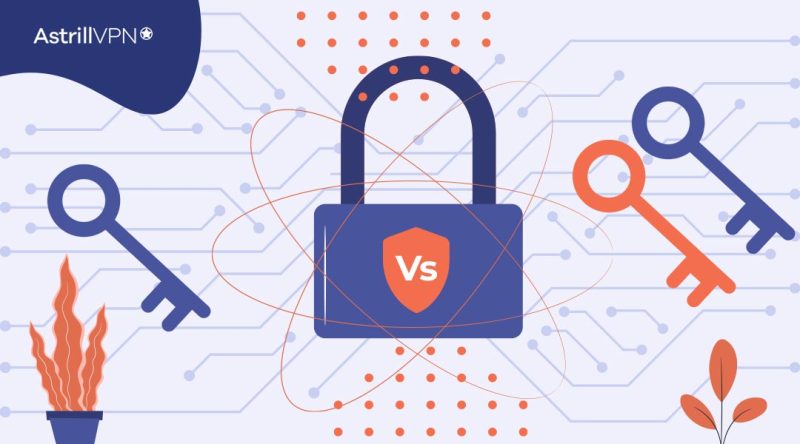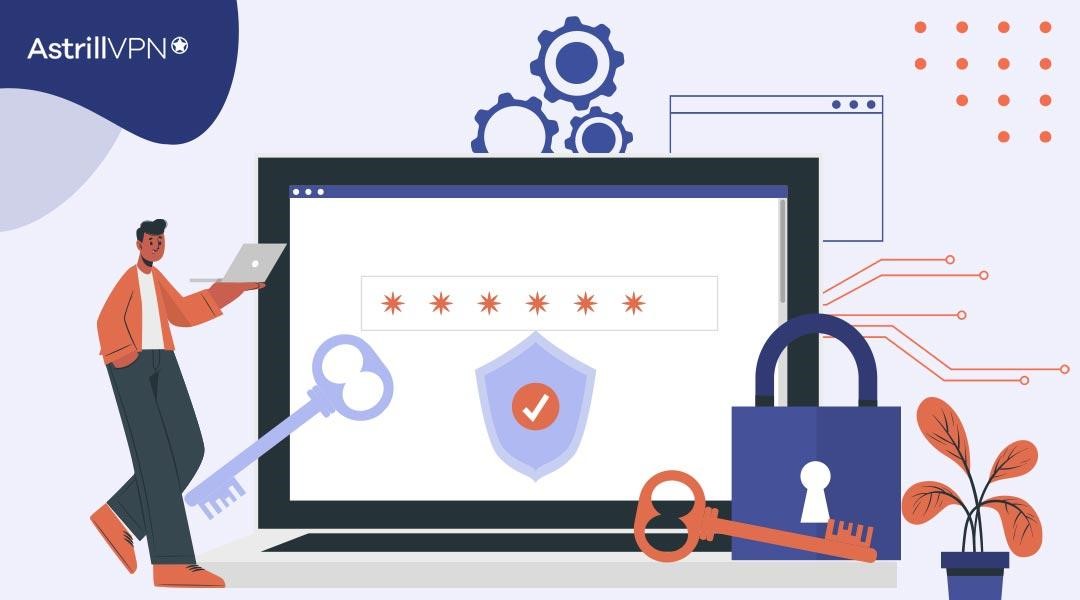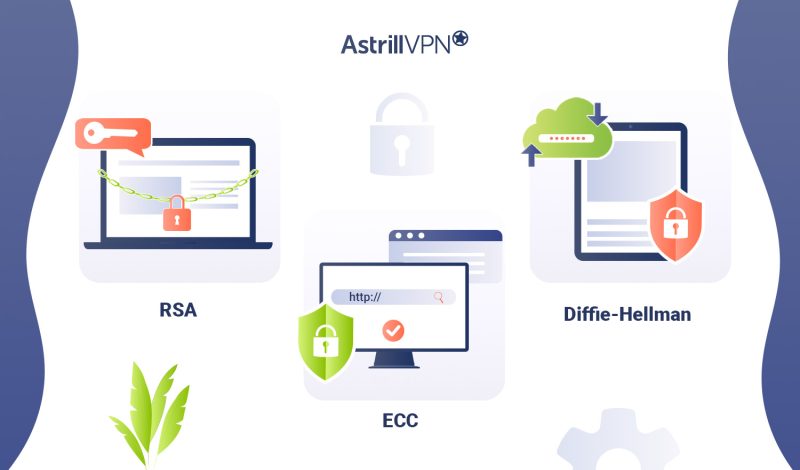Symmetric vs. Asymmetric Encryption: What are the Key differences?

Bisma Farrukh

Encryption is how we keep data private in an increasingly digital world. Whether you’re trying to protect your personal files, communications, or business data, understanding encryption methods is key. The two main types are symmetric encryption, where the same key is used to encrypt and decrypt data, and asymmetric encryption, which uses a public key to encrypt data and a private key to decrypt it. Both have a role to play in data security, so let’s dive in and explore how they work, their pros and cons, and how you can use them to protect your own information. By the end of this article, you’ll have a solid understanding of the differences between these two foundational encryption techniques.
Table of Contents
What Is Symmetric Key Encryption?

Symmetric encryption uses a single key to both encrypt and decrypt data. This means the same key is used by both the sender and recipient.
The main benefit of symmetric encryption is that it’s fast. It’s ideal for encrypting large amounts of data. The downside is that you have to share the key with the recipient in a secure way. If the key is compromised, anyone can access the encrypted data.
Some common examples of symmetric encryption algorithms are:
- AES (Advanced Encryption Standard)
- Blowfish
- RC4
Symmetric encryption is best used when speed and efficiency matter and when a secure key exchange system is in place. For most people, symmetric encryption may be tricky to implement effectively due to the key sharing challenge.
Common Symmetric Encryption Algorithms
With symmetric encryption, the same key is used to encrypt and decrypt the data. This includes algorithms like:
- AES (Advanced Encryption Standard) – The most commonly used algorithm. Fast and secure for encrypting files, disks, and network connections.
- DES (Data Encryption Standard) – An older algorithm that uses a 56-bit key. Not the most secure, but still used in legacy systems.
- 3DES – Uses three rounds of DES encryption with different keys to increase security. Also still used in older systems.
- Blowfish– A fast, public domain algorithm suitable for applications where the key does not change often.
- RC4 -A stream cipher used in popular protocols like Secure Sockets Layer (SSL) to protect Internet traffic. On the contrary, a block cipher is a type of encryption algorithm that operates on fixed-length groups of bits called blocks. It takes plaintext as input, along with a key, and produces ciphertext as output. The block cipher processes the input one block at a time where each block is encrypted or decrypted independently. This encryption method is commonly used to secure data in various applications like network communication, disk encryption, and digital signatures.
Symmetric encryption is fast and efficient, but the big downside is that you must securely share the key with anyone who needs to decrypt the data. For now, remember that if you need to quickly encrypt data where security and speed matter, symmetric encryption and the AES algorithm are probably your best friends.
Examples of symmetric encryption
There are several popular examples of symmetric encryption that are commonly used.
- AES encryption is probably the best known today. AES uses keys of 128, 192, or 256 bits to encrypt data and keep it secure. It would literally take billions of years to crack an AES encrypted file! That’s why it’s so widely adopted by governments, banks, hospitals and other businesses that need to protect sensitive information.
- DES was the previous standard, but it’s now considered outdated since modern computers can break it relatively easily. The government standards group NIST has even withdrawn its recommendation of DES because it’s just not secure enough anymore.
- Triple DES, which was intended to be more secure than regular DES, is also being phased out and discontinued because of weaknesses over time.
- Another historical algorithm was IDEA as an alternative to DES. While it provided stronger security than DES at the time, AES has proven to be even better and is now the preferred choice. IDEA is still an open standard but not really used much anymore.
- When you connect to websites securely using HTTPS or make encrypted phone calls, that connection is usually secured using TLS or its predecessor SSL. These protocols use symmetric encryption. They generate unique secret keys just for the connection between the client (like your phone or laptop) and the server. Every session gets its own unique keys, keeping the communication private.
What Is Asymmetric Key Encryption?

Asymmetric encryption is more computationally intensive than symmetric encryption, so it is often used to encrypt a symmetric key which is then used to encrypt bulk data. This combines the efficiency of symmetric encryption with the security of asymmetric encryption.
Asymmetric encryption uses two separate keys for encrypting and decrypting data. There is a public key and a private key. The public key can be shared with anyone and is used to encrypt messages. The private key is kept secret and is used to decrypt messages that were encrypted with the public key.
Because the public key cannot decrypt messages that were encrypted with it and the private key is kept secret, this method is very secure. Asymmetric encryption is often used when communicating over the internet or storing sensitive data in the cloud, where public keys can be exchanged to facilitate secure communication.
Anyone with the public key can encrypt data that can only be decrypted by the holder of the private key. This also allows for digital signatures because data encrypted with the private key can be decrypted with the public key, proving that the message is authentic.
Common Asymmetric Encryption Algorithms
RSA
RSA is one of the first public-key cryptosystems and is still widely used today. It utilizes a public key and a private key. The public key can be shared with anyone, while the private key must be kept secret. RSA works by generating two large prime numbers to create a public key and a private key. The public key is used to encrypt messages and the private key is used to decrypt them.
ECC
Elliptic curve cryptography (ECC) uses algebraic curves over finite fields to generate public and private keys. ECC uses smaller keys than RSA to provide the same security level. This results in faster computations, lower power consumption, as well as memory and bandwidth savings. ECC is a popular choice for constrained environments like mobile devices.
Diffie-Hellman
The Diffie-Hellman key exchange method allows two parties to establish a shared secret key over an insecure channel. It enables two parties to agree upon a secret key without any prior knowledge and without exchanging any secret information over the channel. Diffie-Hellman is used in many internet security protocols like SSH, IPsec, SSL, and TLS.
By using a combination of these algorithms, we can build secure communication systems.

Examples of Asymmetric encryption
There are a few common examples of asymmetric encryption methods used today.
- One of the oldest is RSA encryption, which was developed by Ron Rivest, Adi Shamir, and Leonard Adleman. RSA works by generating a public key from two large prime numbers and a private key from those same numbers. Then, information is encrypted with the public key and decrypted with the private key, which is how asymmetric encryption works.
- Another important one is the Digital Signature Standard, or DSS for short. This includes the Digital Signature Algorithm and is great for digitally signing things to verify who sent them. When you sign something with your private key, others can use your public key to confirm it really came from you. This helps prevent suspicious or unauthorized sources from pretending to be someone else.
- Elliptical Curve Cryptography, or ECC, is sometimes used instead of RSA because it uses smaller key sizes but still provides strong security. In fact, many cryptocurrencies like Bitcoin use ECC under the hood. Specifically, they use the Elliptic Curve Digital Signature Algorithm, also known as ECDSA, to sign transactions securely.
- Diffie-Hellman was a real breakthrough that lets two parties securely exchange keys even over unsecure channels, without having to pre-share keys in person. Before it was invented, securely communicating required pre-exchanging keys face-to-face. Now, thanks to Diffie-Hellman, keys can be agreed upon remotely in a way that prevents third parties from spying.
- Finally, the TLS/SSL protocol uses asymmetric encryption for something called a “TLS handshake.” This handshake allows a client and server to securely generate symmetric encryption keys to encrypt their ongoing session. Asymmetric encryption kicks off the secure communication, with symmetric encryption taking over for efficiency.
When to Use Symmetric vs. Asymmetric Encryption?
When Speed and Efficiency Matter Most
Use symmetric encryption when you need to encrypt large amounts of data quickly and decrypt it efficiently. Things like:
- Encrypting files on a USB drive
- Protecting data in transit over a network
- Securing communications in messaging apps
Symmetric encryption uses a single secret key to both encrypt and decrypt data. This makes it fast since the same algorithm is used for encryption and decryption. The downside is that the secret key must be shared between the sender and recipient, which requires a secure key exchange method.
For Ultimate Security
Choose asymmetric encryption when security is your top priority. Some examples:
- Encrypting sensitive data like credit card numbers
- Securing government and healthcare records
- Protecting intellectual property
Asymmetric encryption uses a public key to encrypt data and a private key to decrypt it. However, asymmetric encryption is significantly slower and cannot efficiently encrypt large amounts of data.
A hybrid solution
For most everyday encryption needs, a hybrid solution using both symmetric and asymmetric encryption works well. Asymmetric encryption is used to securely exchange a symmetric key, then symmetric encryption is used for the actual data encryption due to its speed and efficiency. This provides the perfect balance of security and performance.
Symmetric Vs Asymmetric Encryption
Symmetric and asymmetric encryption are two of the most common types of cryptography.
| Symmetric encryption | Asymmetric encryption |
| Symmetric encryption uses the same key for both encryption and decryption. This single key must be shared between the sender and receiver before any data can be exchanged. | Asymmetric encryption uses two separate keys for encryption and decryption. One key is public and can be shared with anyone. The other key is private. Anything encrypted with the public key can only be decrypted using the private key. |
| Symmetric encryption tends to be faster than asymmetric, but sharing secret keys can be tricky. | Asymmetric encryption solves this problem since the public key can be distributed openly, and anything encrypted with it can only be read by the holder of the private key. |
| Symmetric algorithms like AES and DES are faster and less resource-intensive. | Asymmetric algorithms like RSA and ECC are slower but more secure. |
| Symmetric encryption is best for bulk encryption of data. | Asymmetric encryption is ideal for encrypting small amounts of data, like encryption keys. |
Examples of Symmetric Encryption
Symmetric encryption is best for encrypting data where both the sender and receiver can access the key, such as storing data on a local drive or flash drive.
Public key encryption is typically better for communication over the Internet since it solves the problem of securely exchanging the keys.
Examples of Asymmetric Encryption
Asymmetric encryption allows for secure communication over the internet because the public key can be openly shared while the private key remains secret. This allows two parties who have never met before to communicate securely.
Does Astrill VPN use symmetric or asymmetric encryption?
Astrill VPN uses both symmetric and asymmetric encryption to protect users’ data and ensure privacy.
Symmetric Encryption
Astrill VPN uses strong 256-bit AES symmetric encryption to encrypt all data between your device and Astrill’s servers. AES is a robust cipher that would take an impractical amount of time to crack. Your data and activity are hidden from anyone trying to snoop on your connection.
Asymmetric Encryption
Astrill VPN uses asymmetric encryption like 2048-bit RSA and Diffie-Hellman for key exchange and authentication. Asymmetric encryption allows keys to be exchanged over the public internet without compromising security. Your private key is kept secure on your device, while your public key can be shared. This dual encryption approach is considered very secure.
The Best of Both Worlds
Astrill VPN provides fast, secure encryption and authentication by combining symmetric and asymmetric encryption. Symmetric encryption quickly encrypts your data traffic, while asymmetric encryption securely handles key exchange and login credentials. This hybrid model gives you the best speed and security in one VPN solution.
FAQs
Got questions about symmetric vs. asymmetric encryption? Here are some common ones:
Asymmetric encryption like RSA and ECC are not symmetric. They use different keys to encrypt and decrypt data.
VPNs typically use asymmetric encryption to establish a secure connection and exchange keys, then use symmetric encryption for the actual data transfer due to its speed.
Symmetric encryption uses the same key to encrypt and decrypt data, while asymmetric encryption uses different keys. Asymmetric is slower but better for key exchange.
Conclusion
At the end of the day, for most of your basic needs, symmetric encryption works just fine and dandy. But if you need to securely share information or verify someone’s identity, asymmetric encryption is the way to go. The differences between the two come down to a balancing act between speed and security. Choose the option that meets your needs, implement it properly, and your data will be locked up tight.

No comments were posted yet